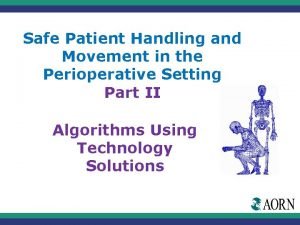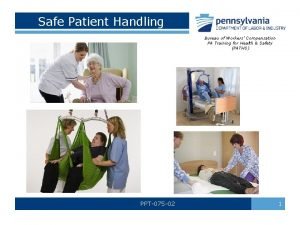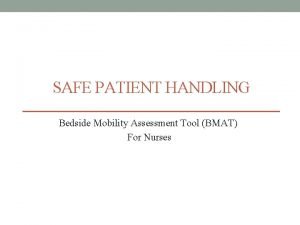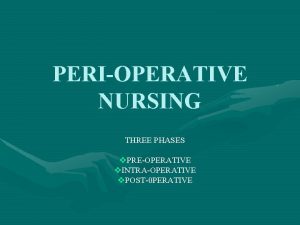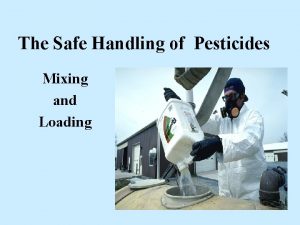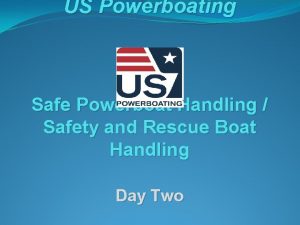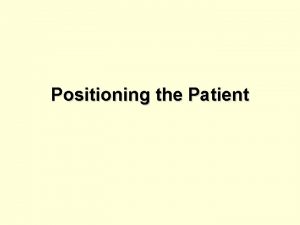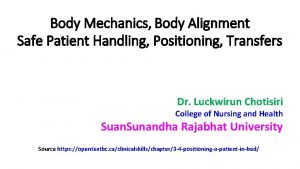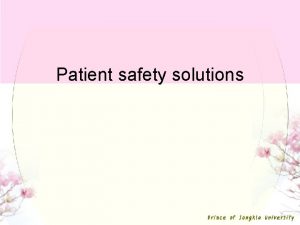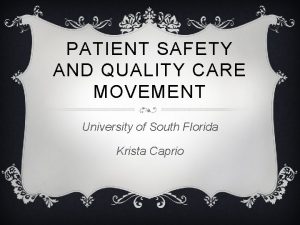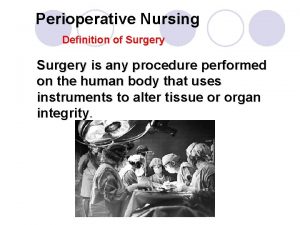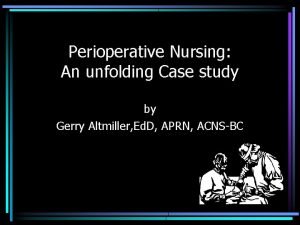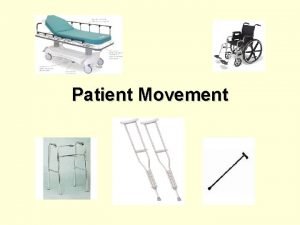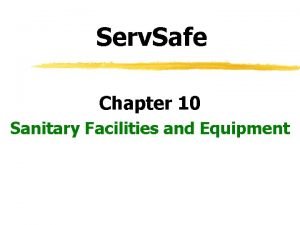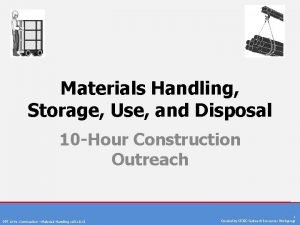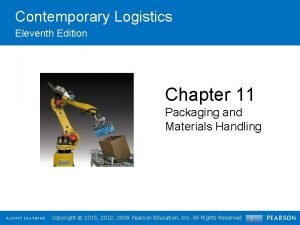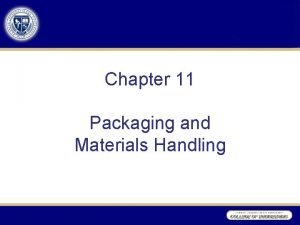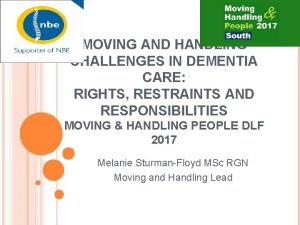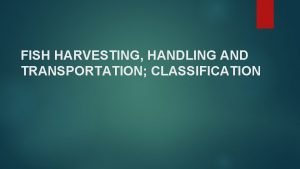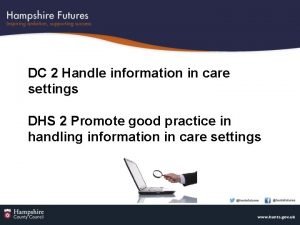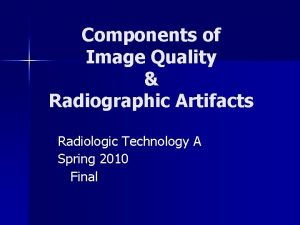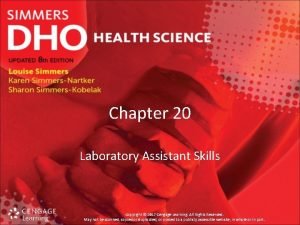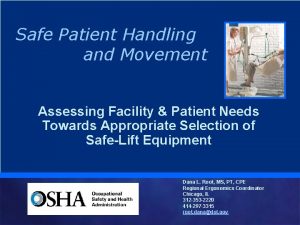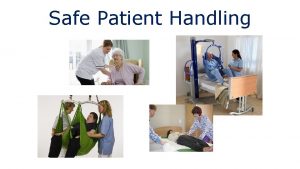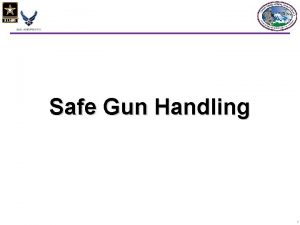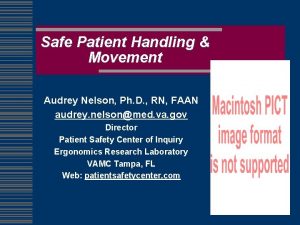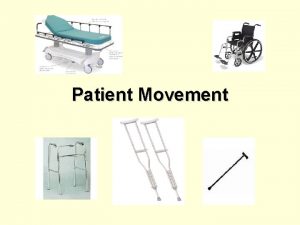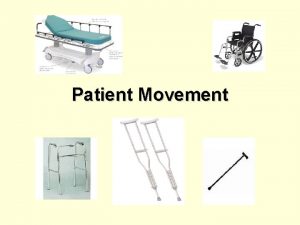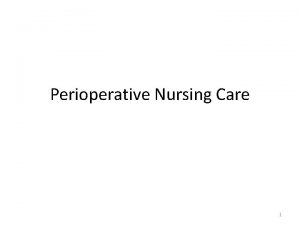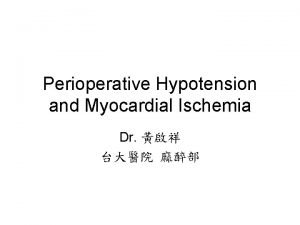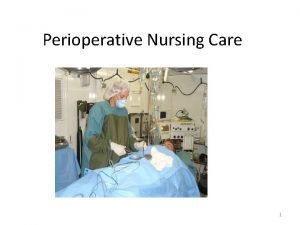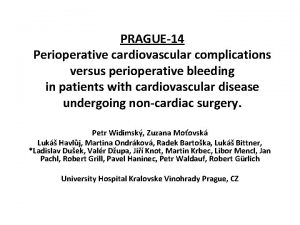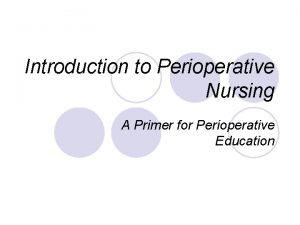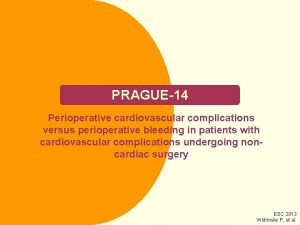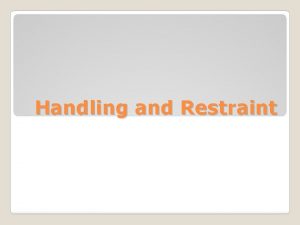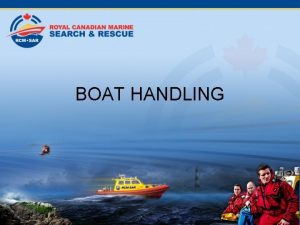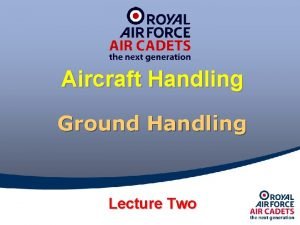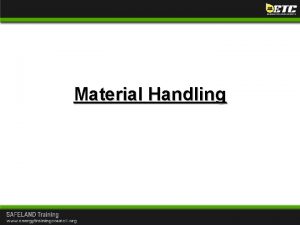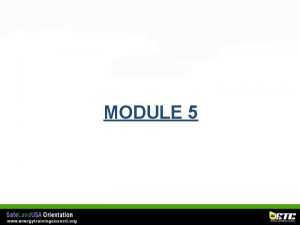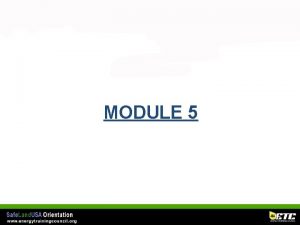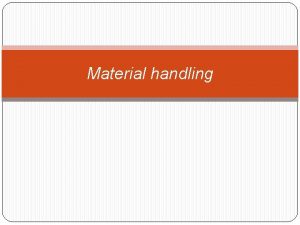Safe Patient Handling and Movement in the Perioperative










































































- Slides: 74

Safe Patient Handling and Movement in the Perioperative Setting Part II Algorithms Using Technology Solutions

Algorithms in the AORN Ergonomic Tools Developed by an interdisciplinary task force that included experts in ergonomics • • • biomechanics engineering industrial hygiene injury prevention perioperative nursing

Interdisciplinary Task Force Representatives from • AORN • National Institute for Occupational Safety and Health (NIOSH) • Patient Safety Center of Inquiry at the James A. Haley Veterans Administration Medical Center • American Nurses Association (ANA)

Interdisciplinary Task Force Identified high-risk perioperative tasks • • • transferring patients on and off OR beds repositioning patients on OR beds lifting and holding patients’ extremities standing for long periods of time holding retractors for long periods of time reaching, lifting and moving equipment

Interdisciplinary Task Force • Developed the ergonomic tools based on the assessment • The ergonomic tools • incorporate current ergonomic safety concepts, scientific evidence, and the use of technology • include the supporting scientific calculations

Algorithms Standardize decisions to • Perform tasks safely • Determine which type of equipment is required • Determine the number of caregivers required

AORN Safe Patient Handling and Movement Tool Kit Ergonomic Tools • • Algorithms Evidence-based Goal: to eradicate job-related musculoskeletal disorders in perioperative nurses

AORN Safe Patient Handling and Movement Tool Kit Ergonomic Tools for Perioperative Safe Patient Handling and Movement 1. 2. 3. 4. 5. 6. 7. Lateral Transfers Positioning/Repositioning on OR bed Lifting and Holding Legs, Arms, and Head Prolonged Standing Retraction Lifting and Carrying Supplies/Equipment Pushing, Pulling, and Moving Wheeled Equipment

AORN Safe Patient Handling and Movement Tool Kit Ergonomic Tool 1 Lateral Transfers

Can patient transfer without assistance? Start No Yes Caregiver assistance not required. Stand by for safety as needed Prone No Is weight >73 lb? What is the starting position? Supine Will the patient stay supine? No Yes Use 2 -3 caregivers* Yes Use lateraltransfer device* Use assistive technology* No Is weight >157 lb? Yes Use lift with supine sling or lateral-transfer device*

AORN Safe Patient Handling and Movement Tool Kit Yes

AORN Safe Patient Handling and Movement Tool Kit No

AORN Safe Patient Handling and Movement Tool Kit

AORN Safe Patient Handling and Movement Tool Kit Ergonomic Tool 1 Rationale Supine to Supine Transfer § Anesthesia professional always supports the patient’s head and neck (8. 4% of body weight) § Up to 72. 6% of weight required to use lateral transfer device § Remaining 91. 6% (100%-8. 4%) of patient weight not supported by anesthesia professional requires forces up to 66. 5% of the patient’s weight to transfer (72. 6% of 91. 6%).

AORN Safe Patient Handling and Movement Tool Kit Ergonomic Tool 1 Rationale Supine to Supine Transfer § Liberty Mutual Psychophysical tables: • pulling task of less than 6. 9 feet • performed at most once every 30 minutes • maximum sustained force of 35 lb was acceptable to 75% of US females § Each caregiver can safely transfer up to 53 lb (66. 5% of 53 = 35) § With an anesthesia professional, • 2 caregivers can safely transfer up to 105 lb • 3 caregivers can safely transfer up to 158 lb

AORN Safe Patient Handling and Movement Tool Kit

AORN Safe Patient Handling and Movement Tool Kit Ergonomic Tool 1: Rationale: Supine-to-Prone Transfer • Anesthesia professional supports the patient’s head and neck (8. 4% of body weight) • Maximum worst-case two-handed load is 22. 2 lb per caregiver • 3 caregivers + anesthesia professional can safely transfer a patient up to 72. 7 lb without assistive technology • 3 caregivers x 22. 2 lb = 66. 6 lb • 8. 4% of 72. 7 lbs. = 6. 1 lb • 66. 6 lb + 6. 1 lb = 72. 7 lb

AORN Safe Patient Handling and Movement Tool Kit Supine-to-Supine Transfer: Various Devices

AORN Safe Patient Handling and Movement Tool Kit Supine-to-Supine Transfer: Air-assisted Lateral Transfer Device

AORN Safe Patient Handling and Movement Tool Kit Air-assisted Lateral Transfer Device § Risk reducing § Promoting perioperative team efficiency § Features § perforated chambers § a cushion of air § one or two staff members to perform a task that typically requires four to eight people

AORN Safe Patient Handling and Movement Tool Kit Supine-to. Supine Transfer: Friction-Reducing Device

AORN Safe Patient Handling and Movement Tool Kit Supine-to. Supine Transfer: Powered Mechanical Device

Mechanical Lift Device

AORN Safe Patient Handling and Movement Tool Kit Prone-to-Prone Transfer: Ceiling Lift and Sling

AORN Safe Patient Handling and Movement Tool Kit Supine-to-Prone Transfer Manual Mechanical Device

AORN Safe Patient Handling and Movement Tool Kit Ergonomic Tool 2 Positioning or Repositioning on the OR Bed

AORN Safe Patient Handling and Movement Tool Kit Positioning or Repositioning on the OR bed Use tool #2 to assess needs when repositioning the patient to or from the supine position while on the OR bed • There are three primary positions: • Semi-Fowler • Lateral • Lithotomy • Recommendations are given relative to patient body weight (BW)

Tool #2: Positioning and Repositioning the Patient on the OR bed to and from the Supine Position What is the Surgical position? To/From semi-Fowler Using beach chair device Start 2 A To/From Lateral 2 B To/From Lithotomy 2 C

2 A To/From semi-Fowler Using beach chair device Is the patient < 68 lb? yes (See 1 below) Manual lifting or lowering of torso (min. 3 caregivers) no Use assistive technology Proceed (min. 3 caregivers) with (See 1 and 2 below) Procedure

AORN Safe Patient Handling and Movement Tool Kit Rationale Positioning and Repositioning the Patient in OR Bed (eg, semi-Fowler) • The mass of the body from the waist up is 68. 6% of body weight, plus equipment weight of 20 lb • Maximum worst-case two-handed load is 22. 2 lb per caregiver • 3 caregivers can safely transfer a patient up to 68 lb

2 B To/From Lateral Is the patient < 115 lb? yes Manual positioning approved no Use assistive technology (min. 3 caregivers) (See 1 below) (min. 4 caregivers) Proceed with Procedure

AORN Safe Patient Handling and Movement Tool Kit Rationale Positioning and Repositioning the Patient in OR Bed • Lateral positioning requires push/pull forces • Assuming anesthesia professional supports the patient's head and neck then remaining mass is 91. 6% of BW • Acceptable push/pull force person = 35 lb • 3 caregivers plus anesthesia professional can safely transfer a patient weighing up to 115 lbs [(35 lbs x 3)/. 916 = 115 lbs]

2 C To/From Lithotomy Is the patient < 141 lbs? yes Manual 2 -handed lift of legs no (min. 2 caregivers [one each leg] or use assistive technology) (See 1 below) Use assistive technology Proceed (min. 3 caregivers) With (See 1 below) Procedure

AORN Safe Patient Handling and Movement Tool Kit Rationale: Positioning and Repositioning the Patient in OR Bed (ie, Lithotomy) • One lower patient extremity is 15. 7% of patient’s BW • Maximum worst-case two-handed load is 22. 2 lbs. per caregiver • If two caregivers perform task, each lifting one leg using both hands, then the maximum patient weight would be 141 lb (141 x. 157 = 22. 1 lb)

AORN Safe Patient Handling and Movement Tool Kit Examples of Body-Part Positioners MANUAL SHOULDER ARTHROSCOPY POSITIONER LATERAL BRACE FOR SHOULDER POSITIONERS

Example of Body-Part Positioners

AORN Safe Patient Handling and Movement Tool Kit Ergonomic Tool 3 Lifting and Holding Legs, Arms, and Head

AORN Safe Patient Handling and Movement Tool Kit Ergonomic Tool 3 • Patient-weight categories t • Very Light (< 40 lb) to • Very Heavy (> 440 lb) • If weight limits are exceeded, • additional team members are recommended to help • use assistive devices

AORN Safe Patient Handling and Movement Tool Kit Lifting and Holding Legs, Arms, and Head • Weight limits • One- and two-handed lifting • Endurance times for holds of respective body parts • 0, 1, 2, or 3 minutes • One or two hands

AORN Safe Patient Handling and Movement Tool Kit Lifting and Holding Legs, Arms and Head • Acceptability of task is dependent on patient weight. • Table indicates whether it would be acceptable for one caregiver to lift or hold the listed body part. • Respecting these limits should minimize risk of muscle fatigue and the potential for musculoskeletal disorders

AORN Safe Patient Handling and Movement Tool Kit Questions Regarding Lifting and Holding Legs, Arms, and Head § Does limb need to be raised for the entire surgical skin prep? § Does limb need to be lifted by scrubbed or unscrubbed personnel? § Is the person holding the limb strong enough to perform the task? § Is there an alternative practice that can be adopted? § Is there equipment that could be used to support the task? § Is it possible to hold a heavy limb safely without risk of injury to the nurse or patient?

AORN Safe Patient Handling and Movement Tool Kit Lifting and Holding Legs, Arms, and Head • Maximum lift and hold for load limits • Normalized weight for each leg, arm, and head are calculated as a percentage of body weight (BW), where: • Lower extremity = 15. 7% BW • Upper extremity = 5. 1% BW • Head and neck = 8. 4% BW

AORN Safe Patient Handling and Movement Tool Kit Lifting and Holding Legs, Arms, and Head • The maximum weight for a • one-handed lift is 11. 1 lbs • two-handed lift is 22. 2 lbs • Fatigue limits for holding • After 1 minute, muscle endurance has decreased by 48% • After 2 minutes it has decreased by 65% • After 3 minutes muscle endurance has decreased by 71%

AORN Safe Patient Handling and Movement Tool Kit Ergonomic Tool 4 Prolonged Standing

Ergonomic Tool #4: Does caregiver Prolonged Standing stand in same position Yes Start >2 hours at a time or >30% of work day? Use fatigue-reducing technique or technology No Does procedure require the use of lead aprons? No No intervention required Limit to 1 hour, use portable sit-to-stand stool or portable lead shield

AORN Safe Patient Handling and Movement Tool Kit Ergonomic Tool 4 Aids for Prolonged Standing • Supportive footwear • Support stockings/socks • Antifatigue mats, flooring, or standing stools • Sit-stand chair • Moving head approximately every minute • 2 -piece light-weight lead apron

Antifatigue mat and stool

Sit-stand stool

AORN Safe Patient Handling and Movement Tool Kit Ergonomic Tool 5 Retraction

Ergonomic Can Tool #5: a self-retaining retractor Yes Start Retraction be safely used for Use self-retaining retractor the task? No but. . . • Assistant should be at optimal height and posture for manual retraction • Hold retractor as close to body as possible and maintain good posture Yes Is manual retraction also necessary?

AORN Safe Patient Handling and Movement Tool Kit Retraction When providing retraction: § use arm rests, if possible § take rest breaks or reposition, when possible § avoid using the hands as a retractor to lessen the risk of sharps injury risk

AORN Safe Patient Handling and Movement Tool Kit Implementation Suggestions • Use blunt retractors

AORN Safe Patient Handling and Movement Tool Kit Implementation Suggestions • Use mechanical/instrument tissue retraction.

AORN Safe Patient Handling and Movement Tool Kit Use of Hoyer lift for retraction in surgery

AORN Safe Patient Handling and Movement Tool Kit Ergonomic Tool 6: Lifting and Carrying Supplies/Equipment

AORN Safe Patient Handling and Movement Tool Kit Lifting and Carrying Supplies/Equipment • Manual lifting and carrying of object • physically demanding • may place the worker at substantial risk of low back pain • NIOSH has developed a lifting equation • Personnel can calculate the Recommended Weight Limit (RWL) and Lifting Index (LI) for a specified lifting task

AORN Safe Patient Handling and Movement Tool Kit Lifting and Carrying Supplies/Equipment • AORN Recommendation • Limit the weight of instrument trays to 25 lb total weight • The Association for the Advancement of Medical Instrumentation (AAMI) • Suggests that instrument trays weigh no more than 25 lb

AORN Safe Patient Handling and Movement Tool Kit NIOSH Lifting Index (LI) LI = Weight of Load Lifted/RWL Example Assuming the RWL for a job was 15 kg and the weight lifted was 35 kg, the LI would be: LI = 35 = 2. 3 15

Lifting Task 3, 000 ml irrigation fluid Key Lifting Index <0. 2 Sand bags 0. 3 Linen bags 0. 4 Lead aprons 0. 4 Custom sterile packs (eg, heart or spine) 0. 5 Garbage bags (full) 0. 7 Positioning devices off shelf or rack (eg, stirrups) 0. 7 Positioning devices off shelf or rack (eg, gel pads) 0. 9 Hand table (49” x 28”)-largest hand tableused infrequently 1. 2 Fluoroscopy Board (49” x 21”) 1. 2 Stirrups (2 - one in each hand) 1. 4 Wilson frame 1. 4 Irrigation containers for lithotripsy (12, 000 ml) 1. 5 Instrument pans 2. 0 No shading Level of Risk Minimal risk – Safe to lift Light shading Potential risk – Use assistive technology, as available Heavy shading Considerable risk – one person should not perform alone or weight should be reduced.

AORN Safe Patient Handling and Movement Tool Kit Rationale Lifting/Carrying Supplies and Equipment • NIOSH Lifting Equation • assessed a series of typical manual lifting tasks performed by perioperative RNs • Recommended Weight Limit (RWL) • amount of weight that can be safely lifted without an increased risk of the worker developing lifting-related low back pain.

AORN Safe Patient Handling and Movement Tool Kit Rationale Lifting/ Carrying Supplies and Equipment Lifting Index (LI) Ratio of Weight to be lifted (L) divided by (LI = L/RWL) LI < 1. 0 is considered safe for most workers. LI > 1. 0 < 2. 0 is considered to have a moderate level of risk LI > 2. 0 has a significantly increased risk of low back pain

AORN Safe Patient Handling and Movement Tool Kit Low back pain prevalence by Lifting Index

AORN Safe Patient Handling and Movement Tool Kit Foot Pedal Operation Power Fluid Lifters

AORN Safe Patient Handling and Movement Tool Kit Ergonomic Tool 7 Pushing, Pulling, and Moving Wheeled Equipment

AORN Safe Patient Handling and Movement Tool Kit Pushing, Pulling, and Moving Wheeled Equipment • Measured forces required to push common equipment • Maximum acceptable distances for required pushing forces • Specific recommendations based on data • General recommendations based on biomechanics

AORN Safe Patient Handling and Movement Tool Kit Rationale Ergonomic Tool 7 § Initial force used is a “worst-case scenario” in which wheels are turned to oppose motion § Sustained force is an amount required to keep equipment rolling. § Mean force values of five trials were used § All forces must be acceptable to 75% of women at specified distances

AORN Safe Patient Handling and Movement Tool Kit General Recommendations for All Equipment • Pushing is preferable to pulling • Push at a comfortable “middle” height • If the push point is lower, reduce maximum allowable forces by ≈15% • If the task is more frequent than once every 30 minutes, reduce maximum forces by ≈6% • Maintain equipment and casters

AORN Safe Patient Handling and Movement Tool Kit Specific Recommendations for Common OR Equipment

AORN Safe Patient Handling and Movement Tool Kit Transport Devices • Powered transport for otherwise manually driven equipment • (eg, beds, wheelchairs, equipment) • Dramatically reduces caregiver demands

AORN Safe Patient Handling and Movement Tool Kit Ergonomically Designed Utility Cart • Designed to work with the body to reduce repetitive motion injuries • Vertical handles • wrists are in the correct position for pushing and steering • Shelves • proper height • easy loading and unloading

AORN Safe Patient Handling and Movement Tool Kit Copyright 2010, AORN, Inc.

AORN Safe Patient Handling and Movement Tool Kit Summary • Don’t wait to act • Costs will vary • Benefits, in addition to patient safety, are likely to include: • Better retention of nurses • Patient satisfaction • Potential financial advantages • Market the safe patient handling program

AORN Safe Patient Handling and Movement Tool Kit • Using technology for safe patient handling and movement is effective in preventing MSDs • Reliance on body mechanics is not safe and does not prevent MSDs • Equipment and programs are cost effective

AORN Safe Patient Handling and Movement Tool Kit The end
 Handling patients
Handling patients Safe patient handling
Safe patient handling Bedside mobility assessment tool
Bedside mobility assessment tool Define the three phases of perioperative patient care
Define the three phases of perioperative patient care Safe handling of pesticides
Safe handling of pesticides 12 golden rules for safe gun handling
12 golden rules for safe gun handling Us powerboating safe powerboat handling
Us powerboating safe powerboat handling Savage safe handling auburn me
Savage safe handling auburn me Safe feed safe food
Safe feed safe food Safe people safe places
Safe people safe places Horizontal
Horizontal Dorsal recumbent position
Dorsal recumbent position Safe patient transfers
Safe patient transfers Patient safe solutions
Patient safe solutions Patient safety and quality care movement
Patient safety and quality care movement Patient 2 patient
Patient 2 patient Non-movement area
Non-movement area Definition of perioperative
Definition of perioperative Perioperative case study nursing
Perioperative case study nursing Canadian perioperative guidelines
Canadian perioperative guidelines Post operative nursing care
Post operative nursing care Gait patterns with walker
Gait patterns with walker 5 axial steps
5 axial steps Hát kết hợp bộ gõ cơ thể
Hát kết hợp bộ gõ cơ thể Frameset trong html5
Frameset trong html5 Bổ thể
Bổ thể Tỉ lệ cơ thể trẻ em
Tỉ lệ cơ thể trẻ em Gấu đi như thế nào
Gấu đi như thế nào Tư thế worm breton
Tư thế worm breton Chúa yêu trần thế alleluia
Chúa yêu trần thế alleluia Các môn thể thao bắt đầu bằng tiếng bóng
Các môn thể thao bắt đầu bằng tiếng bóng Thế nào là hệ số cao nhất
Thế nào là hệ số cao nhất Các châu lục và đại dương trên thế giới
Các châu lục và đại dương trên thế giới Cong thức tính động năng
Cong thức tính động năng Trời xanh đây là của chúng ta thể thơ
Trời xanh đây là của chúng ta thể thơ Mật thư anh em như thể tay chân
Mật thư anh em như thể tay chân Làm thế nào để 102-1=99
Làm thế nào để 102-1=99 Phản ứng thế ankan
Phản ứng thế ankan Các châu lục và đại dương trên thế giới
Các châu lục và đại dương trên thế giới Thể thơ truyền thống
Thể thơ truyền thống Quá trình desamine hóa có thể tạo ra
Quá trình desamine hóa có thể tạo ra Một số thể thơ truyền thống
Một số thể thơ truyền thống Cái miệng nó xinh thế chỉ nói điều hay thôi
Cái miệng nó xinh thế chỉ nói điều hay thôi Vẽ hình chiếu vuông góc của vật thể sau
Vẽ hình chiếu vuông góc của vật thể sau Biện pháp chống mỏi cơ
Biện pháp chống mỏi cơ đặc điểm cơ thể của người tối cổ
đặc điểm cơ thể của người tối cổ Thứ tự các dấu thăng giáng ở hóa biểu
Thứ tự các dấu thăng giáng ở hóa biểu Vẽ hình chiếu đứng bằng cạnh của vật thể
Vẽ hình chiếu đứng bằng cạnh của vật thể Tia chieu sa te
Tia chieu sa te Thẻ vin
Thẻ vin đại từ thay thế
đại từ thay thế điện thế nghỉ
điện thế nghỉ Tư thế ngồi viết
Tư thế ngồi viết Diễn thế sinh thái là
Diễn thế sinh thái là Dot
Dot Số nguyên tố là gì
Số nguyên tố là gì Tư thế ngồi viết
Tư thế ngồi viết Lời thề hippocrates
Lời thề hippocrates Thiếu nhi thế giới liên hoan
Thiếu nhi thế giới liên hoan ưu thế lai là gì
ưu thế lai là gì Sự nuôi và dạy con của hổ
Sự nuôi và dạy con của hổ Sự nuôi và dạy con của hổ
Sự nuôi và dạy con của hổ Sơ đồ cơ thể người
Sơ đồ cơ thể người Từ ngữ thể hiện lòng nhân hậu
Từ ngữ thể hiện lòng nhân hậu Thế nào là mạng điện lắp đặt kiểu nổi
Thế nào là mạng điện lắp đặt kiểu nổi In keeping equipment and facilities safe and sanitary
In keeping equipment and facilities safe and sanitary Potential hazards
Potential hazards Protective packaging and materials handling
Protective packaging and materials handling Protective packaging and materials handling
Protective packaging and materials handling Moving and handling dementia patients
Moving and handling dementia patients Proper handling and use of a microscope
Proper handling and use of a microscope Fish harvesting methods
Fish harvesting methods Handling information in care settings
Handling information in care settings Guide shoe marks artifacts
Guide shoe marks artifacts Chapter 20:11 using reagent strips to test urine
Chapter 20:11 using reagent strips to test urine
